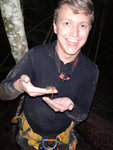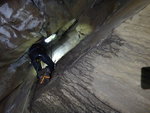









Growing up in the Pacific Northwest, I’ve been to the Ape Caves south of Mount St. Helens a number of times. I went once with some family friends, again with a youth Bible Study group and a third time with a group of people I can’t remember how I met. The cold, dark lava tube has a homey yet mysterious feel, and I still remember the first time we all turned off our lights and found ourselves in absolute and total darkness.
A lava tube, like the Ape Caves, is a natural cave formed by flowing lava that moved under hardened lava in the past. The Ape Caves formed about 1,900 years ago after an eruption of Mount St. Helens. Lava tubes exist all around volcano country. There are the big and popular ones such as the Ape Caves along with smaller, less traveled caves that are a deeply loved secret among recreational cavers.
Last summer, I found myself head to toe in layers of caving gear and dangling from an 11-millimeter-thick rope above a hole I couldn’t see the bottom of. I was in the middle of the Gifford Pinchot National Forest with no clue about my exact location, and all that went through my mind was, “how the hell did I end up here?”
In mid-summer of last year I received an email from someone who called himself “Caveman Tom.” He said he had a story idea about traversing the deep and dark caves in the Pacific Northwest. I was intrigued and, as someone who takes advantage of any opportunity to try something new and get an adrenaline rush, I messaged him back.
“Caveman Tom” later identified himself as Tom Peterson, a machinist by day. But on Tom’s days off, he seeks out the darkness in caves around the area.
“I just love the little adrenaline rushes I get from the experience,” he told me.
Peterson belongs to the Oregon Grotto, the Vancouver and Portland chapter of the National Speleological Society. On their website, the Oregon Grotto states “promot(ing) the conservation of caves and their natural contents” as their number one goal. Members of the society find, explore and map caves as a hobby. While most of the overworld is mapped out and can easily be seen on Google Earth, many of the places Grotto members go are rarely traversed or haven’t been seen at all. Peterson said the caves the Grotto members find and explore are limited to Grotto members or those they can trust to keep the cave in its natural condition. Peterson started to tell me all about the different caves he has seen and explored and why it’d make a great story.
Only having been in the Ape Caves, I was expecting Tom to pick me up for a day trip to a new cave. I don’t know if I’ve ever been more wrong about something in my life. As it turns out, the Ape Caves are relatively easy to access. There’s a parking lot, stairs and signs with general guidance about how to access the tubes. Finding a group to go with is probably the hardest part about getting in and out of the beloved Northwest attraction. Other caves in the Northwest, however, require training in Single Rope Technique (SRT) and a large amount of fearlessness.
Tom told me to meet in his garage where he could begin my SRT training in a safe, secure place. During my first lesson, I learned the first few lessons of SRT, which is largely done without a belay. There are carabiners, Petzl stops, ascenders, froot loops and more. Having only been in the Ape Cave and taken a single indoor rock climbing class in college, it was pretty easy to say I was way out of my comfort zone.
As I stood in Tom’s garage with a chest harness on, he taught me the basics, like how to climb up using a frog-like technique, what to do if the rope gets stuck and most importantly to absolutely never let go of the rope.
“Your right hand is your brake hand,” Tom told me. “Never, ever let go.”
After training in his garage, Tom had me climb a little higher on a nearby tree. Here we learned how to do changeovers (changing from one rope to the next) and honed the ascending and descending technique. After my run on the tree, Tom felt I was ready to hit the cave in the system known as Wolff’s.
Lava tubes aren’t the only type of cave systems in the Northwest. Wolff’s, which the exact location of is classified, is in the middle of the national forest and is made primarily of tuff rock. It is a different type of cave.
Years ago, when lava flows were forming lava tubes, volcanic explosions were forming tuff, a rock formed from the products of these explosions. Ash, bedrock and magma are some of the primary components of this rock, which appears all over the Mount St. Helens’ volcanic area. The Wolff’s cave system was formed when parts of the ground collapsed, slid and opened up small entrances into the underworld. Lava tubes are large and grandiose while tuff caves are small, compact and extremely dirty.
I met Tom at his house around 7 a.m. where he loaded up his Subaru with the caving essentials, including Petzl stops, helmets, flashlights, food, water and more. Once Tom loaded up what felt like enough rope to escape Alcatraz on a trapeze across the San Francisco Bay, we hit the road.
On the road, my nerves were through the roof and we still hadn’t turned off State Route 503. Up to that point, I had only climbed in my community college level indoor gym and spent a few hours on a rope in a tree. Now I was driving into the middle of the forest to drop into a cave. While it was all my decision, I was still pretty frightened.
We made it to our destination and set up camp on the side of a U.S. Forest Service road near some of the old-growth forest. We were deep into the forest and were about to be deeper underground. At the camp already were two of Tom’s Grotto friends, Laina McNichols and Karl “Dusty” Goldscheider. Dusty and Laina are a part of the Cascade Grotto of the Speleological Society and have traveled farther than Tom and I to go back to these caves, which Dusty has a special place in his heart for.
“Dusty loves the Wolff’s system,” Peterson told me. “He’ll use any excuse he can get to get out into these caves.”
Dusty drove down to the caves from Mount Vernon to rig, rope and dive into the caves with us. While Tom taught me everything I needed to know about climbing and being safe, I felt even better with Dusty around as he had more experience with SRT than anybody in the group and spent time working for the British Columbia Cave Rescue in the 1990s.
“My high is vertical caving,” Dusty told me. “Once I saw my first cave I was hooked. I just love doing it and seeing the structures underground.”
Laina was my moral and understanding support, and I don’t know if I could’ve gotten through the expedition without her. She understood my fear, helped me get through the tough parts and talked me through a lot of the nerve wracking steps of the journey. If one thing is to be said about the caving community, it’s that they’re understanding and welcoming. Her favorite part about the caving experience is how empowering it feels to overcome her fears and do it.
After camp was set up, we hiked out about a mile or so in all of our gear. I wore layers upon layers of clothing because even though it was nearing 85 degrees outside, the caves were cold, dark and wet. As we reached the cave, I was sweating and ready to tackle my fears.
At first I didn’t notice the cave. Unlike the Ape Caves, the entrance to this cave is small, hidden and behind some overgrowth. Dusty began rigging the ropes for the two separate caves. Wolff’s Den and Wolff’s Pit. The Den is smaller, doesn’t go super deep and is a great beginner cave.
The pit on the other hand, goes about 220 feet underground and exposes the ancient layer of the earth. Once Dusty was done rigging up the caves, Laina headed in first with me on deck. Once it was my turn to go, I felt more fear than I’ve ever felt in my life.
I got on my knees and my feet started to dangle.
“It’s a gorgeous Saturday, why am I going where it’s cold and dark?” I said to myself.
I pushed my knees off the wall and it was just me, 25 feet of rope and a whole lot of rock. The descent was relatively easy as I kept my hand on the brake lever and began to go into the Earth. Once my feet hit the bottom, I let out a big breath, unhooked my gear and yelled “off rope,” a signal to let Tom know he was good to go.
My first thought upon entering the cave was “dang, it smells really good down here.” A mix of a dank wet smell with earthy soil gave the notion that this cave was rarely traversed by more than wildlife. Harvestmen spiders, rough-skinned newts and other creepy crawlies like to make this place their home.
Once we were all in the Den, we started to walk around a bit. Dusty was right, this place isn’t that large, but we climbed over a rundown tree and a couple of rocks to the other end of the small shaft. Once there, the Den was basically explored and it was time to resurface before tackling the harder of the two, Woff’s Pit.
Imagine wanting to get on the roof of your house and the only way to do it is climb up the water spout itsy-bitsy spider-like. That’s what climbing out of Wolff’s Den was like as we had to climb through what was aptly named “The Toothpaste Tube.” While going down was a test of courage, going up was a test of endurance, strength and flexibility.
Resurfacing was a relief. As I waited for Tom and Laina to make their way up, I headed to my pack for water and snacks. As I checked the time, I realized we’d been in the cave for about two hours for an expedition that felt like maybe 30 minutes.
“We call it cave time,” Dusty said. “It always goes by quicker on the surface.”
After a quick break, I was ready to tackle a portion of Wolff’s Pit. However, a round-trip tour of the system takes about seven or eight hours and we were losing daylight pretty quickly.
“We’re not going to do the whole cave, right?” I asked, nervous they were all thinking we could do it.
“Not unless you want to come out of here around midnight!,” Dusty and Tom joked.
While we couldn’t do the whole cave, I wanted to see what all the fun was about in the Pit. According to my team, it’s smaller, dirtier and colder.
“I’ve made it this far,” I thought. “Might as well do it again.”
Dropping into Wolff’s Pit was harder than the Den, and once I reached the bottom, I needed to Army-crawl my way under a few rocks. I felt like a mouse headed into a trap.
“There’s no way I should be here,” I thought as my fears rose once again. After a few hours of gruelling physical work to get through a small portion of the system and over a rock deemed the “Man Hater,” we made it to what Dusty, Laina and Tom called the “Pit Room.”
“Here’s where you can drop even further,” Dusty said, pointing out the somewhat large for a cat but tiny for a human sized hole in the wall. “That’s the pitch to Wolff’s Deep and it’s about an 80 foot drop.”
In the Pit Room, it was pitch black and I could see my breath as the temperature was about 45 degrees. On the other side of the room from the pitch to Deep is the aptly-named “Sand Sucking Hole” which contains the vertical drop to Wolff’s Deeper.
As I write this, I wish I would’ve had the courage to see what was down there. Wolff’s Deeper goes about 220 feet underground, which made the 80-foot depth of the Pit Room feel measly. However, at the time, I was exhausted, nervous and had used up all of the energy I had on my quest for excitement.
I hope to make it out to the caves again someday. Whether it’s the Wolff system of caves or something entirely new, the experience I had deep underground was like no other. I bonded with a group of people I didn’t know existed prior to my experience. I faced fears, saw new wildlife and ended up in a place where only a few dozen people had made it before. As you get ready for another season in the great outdoors, I urge you to try something new. Caving isn’t for everyone, but there are adventures out there you’ve never even heard of. If I make it out again, I’ll be sure to let you know.